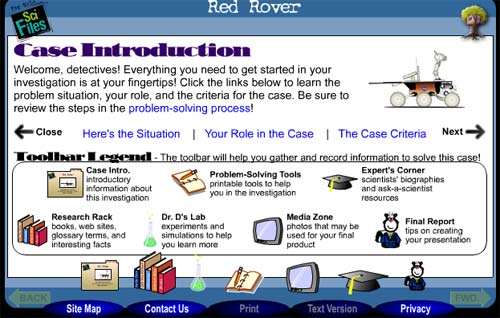« Who Built America? The Expanded Textbook | Main | The Voyager Macbeth: An Expanded Critical Edition »
September 2, 2005
The NASA SCI Files: Problem-Based Learning Introduces Students to Scientific Inquiry

The NASA SCI Files is a research and standards-based series of free integrated mathematics, science, and technology instructional distance learning programs that NASA Langley Research Center created for students in grades 3-5. The series uses Problem-Based Learning (PBL) to introduce students to scientific inquiry while providing students the opportunity to solve real world problems with the help of community experts and NASA researchers.
The program offers a series of television broadcasts that feature the tree house detectives, six children who solve "real world" problems using scientific inquiry. They are helped by their mentor Dr. D and also by NASA researchers, community experts, and students across the country who are members of the SCI Files Kids Club. The Website leads students through online investigations that can be used in tandem with the television broadcasts. Red Rover, for example, is used with "The Case of the Great Space Exploration." This problem-based activity asks students to research the requirements for crewed and uncrewed missions to Mars.

The students choose one of two roles, physiologist or robotics engineer. Each role has a list of research goals and project tasks. Once a role has been selected, the student prints out a "Program Log," with a list of ten questions such as: What is a Physiologist? What does microgravity really mean? How do astronauts exercise in space? Supplementary information, including text, diagrams, images and video, is available on the site to help students answer these challenging questions.

The nature of the supplementary information makes this resource different from a print textbook. Short videos explain long-term space travel problems such as: how food will be grown in space and how will the body be affected by zero gravity? These multi-media learning tools benefit visual and aural learners in ways that print textbooks cannot. Working through a tightly organized collection of media "clues", allows students to experience a sense of discovery while developing problem-solving skills. This dynamic would be difficult to duplicate in the static, linear-formatted print textbook. Finally, students are asked to write up a report of their findings. This journaling activity is designed to model the scientific process.
The NASA education site also provides extensive support for teachers. Educator guides (available as downloadable PDFs) list national science, math, or geography standards satisfied by each respective program. They also offer lesson-planning support including: a program overview, vocabulary, implementation strategy, activities, experiments and worksheets. Teachers can also sign up for classroom mentors, provided by the Society of Women Engineers. These mentors were specifically chosen to raise student awareness of careers in the sciences and to help students "overcome stereotyped beliefs by presenting women and minorities in challenging careers." The mentors assist educators either in person or by e-mail. Educators can find additional resources and support by contacting their local Educator Resource Center (ERC). "Personnel at ERCs located throughout the United States work with teachers to find out what they need and to share NASA's expertise. The ERCs provide educators with demonstrations of educational technologies such as NASA educational Web sites and NASA Television. ERCs provide inservice and preservice training utilizing NASA instructional products."
The depth and breadth of resources NASA has made available to students, parents, and educators makes the site more than just a digital textbook. It is a comprehensive subject-specific full-service digital learning environment. Created by top experts in the field, the space provides curriculum materials similar to those found in print textbooks, but it also vastly expands the territory of the print textbook and the process by which teachers and students explore subject matter.
Posted by kim white at September 2, 2005 2:17 PM
